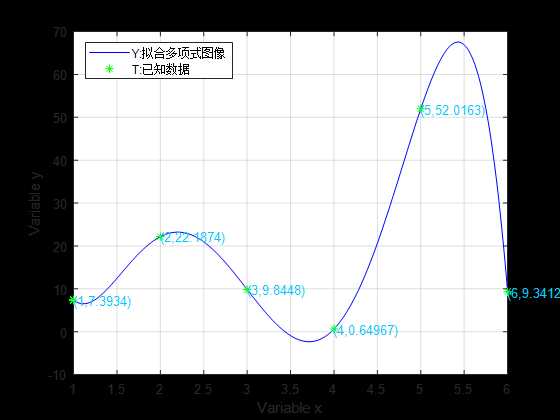多项式插值
Posted guliangt
tags:
篇首语:本文由小常识网(cha138.com)小编为大家整理,主要介绍了多项式插值相关的知识,希望对你有一定的参考价值。
1.多项式插值函数
%%多项式插值
%%说明:precision为精度,越大则图像越精细,attribute是属性值,当未知函数表达式但已知函数值时为1,否则为0
function PI = Polynomial_interpolation(f,X,precision,attribute)
X = sort(X);
if attribute == 0
[m,n] = size(X);MAX = max([m,n]);
X = reshape(X,1,MAX);error = [];
for i = 1:MAX
Y(i) = subs(f,X(i));
end
Y_value =double(Y);
a = min(X);b = max(X);
t = a:(b-a)/precision:b;
T = zeros(1,precision+1);
Yreal = subs(f,t);
Coe = vpa(Polynomial_interpolation_cofficient(f,X,attribute),4);
for i = 1:1:precision+1
T(i) = Polynomial_value(Coe,t(i));
end
for i=1:MAX
error(i) = abs(Y(i)-Polynomial_value(Coe,X(i)));
end
%%作图
h=figure;
set(h,‘color‘,‘w‘);
[hAx,hLine1,hLine2] = plotyy(t,T,X,Y,‘plot‘,‘stem‘);
title(‘多项式插值‘);
xlabel(‘Variable x‘);
ylabel(hAx(1),‘Variable‘);
ylabel(hAx(2),‘Variable‘);
grid on
hold on
plot(t,Yreal);
legend(‘Yreal:真实图像‘,‘Y:拟合多项式图像‘,‘T:实际数据‘);
%%显示坐标
for i = 1:MAX
text(X(i),Y_value(i),[‘(‘,num2str(X(i)),‘,‘,num2str(Y_value(i)),‘)‘],‘color‘,[0.02 0.79 0.99]);
end
disp(‘误差值为‘);error
elseif attribute ==1
[m,n] = size(X);MAX = max([m,n]);X = reshape(X,1,MAX);f = reshape(f,1,MAX);
a = min(X);b = max(X);
t = a:(b-a)/precision:b;
T = zeros(1,precision+1);
Coe = vpa(Polynomial_interpolation_cofficient(f,X,attribute),4);
for i = 1:1:precision+1
T(i) = Polynomial_value(Coe,t(i));
end
h=figure;
set(h,‘color‘,‘w‘);
plot(t,T,‘b‘,X,f,‘g*‘);
grid on
title(‘多项式插值‘);
xlabel(‘Variable x‘);
ylabel(‘Variable y‘);
legend(‘Y:拟合多项式图像‘,‘T:已知数据‘);
for i = 1:MAX
text(X(i),f(i),[‘(‘,num2str(X(i)),‘,‘,num2str(f(i)),‘)‘],‘color‘,[0.02 0.79 0.99]);
end
end
syms x;
PI=vpa(Polynomial_value(Coe,x),4);
end
2.多项式函数值
%%多项式函数值
function PV = Polynomial_value(P,t)
[m,n] = size(P);
MAX = max([m,n]);
sum = 0;
for i = MAX:-1:1
sum = sum+P(i)*Power_function(i-1,t);
end
PV = sum;
%%幂函数
function pf = Power_function(index,t)
pf = t.^index;
end
end
3.多项式系数
%%此函数可得出给定节点数减一的多项式系数
%%说明:attribute是属性值,当未知函数表达式但已知函数值时为1,否则为0
function PIC = Polynomial_interpolation_cofficient(f,X,attribute)
global MAX;global m;global n;global i;
X = sort(X);
if attribute == 0
[m,n]=size(X);MAX=max([m,n]);
X = reshape(X,1,MAX);
A = zeros(MAX,MAX);Y = zeros(1,MAX);
for i = 1:MAX
A(:,i) = (X‘).^(i-1);
Y(i) = subs(f,X(i));
end
Coefficient = vpa(reshape(A(Y‘),1,MAX),4);
elseif attribute == 1
[m,n]=size(X);MAX=max([m,n]);PIC=cell(1,MAX+1);
X = reshape(X,1,MAX);
A = zeros(MAX,MAX);Y = reshape(f,1,MAX);
for i = 1:MAX
A(:,i) = (X‘).^(i-1);
end
Coefficient = vpa(reshape(A(Y‘),1,MAX),4);
end
disp(‘最高次数n=‘);
MAX-1
PIC=Coefficient;
%%多项式函数值
function PV = Polynomial_value(P,t)
[m,n] = size(P);
MAX = max([m,n]);
sum = 0;
for i = MAX:-1:1
sum = sum+P(i)*Power_function(i-1,t);
end
PV = sum;
%%幂函数
function pf = Power_function(index,t)
pf = t.^index;
end
end
end
4.一个例子
clear all
clc
precision=500;
X=1:1:6;
R1=reshape(rand(6),1,36);
R2=reshape(rand(12),1,144);
R=zeros(1,6);
for i=1:6
R(i)=R1(6*i)*R2(24*i)*100;
end
%%已知函数
disp(‘已知函数的多项式拟合‘);
syms x;
f=x*sin(x^2)*exp(-x^2)+log(abs(sin(x)));
Polynomial_interpolation(f,X,precision,0)
%%已知函数数值
disp(‘已知函数值的多项式拟合‘);
Polynomial_interpolation(R,X,precision,1)
结果
已知函数的多项式拟合
最高次数n=
ans =
5
误差值为
error =
1.0e-08 *
0.0066 0.0092 0.0027 0.0473 0.1507 0.3463
ans =
0.1248*x^5 - 2.291*x^4 + 15.64*x^3 - 48.61*x^2 + 66.56*x - 31.29
已知函数值的多项式拟合
最高次数n=
ans =
5
ans =
- 1.993*x^5 + 31.02*x^4 - 175.7*x^3 + 444.1*x^2 - 491.6*x + 201.5


以上是关于多项式插值的主要内容,如果未能解决你的问题,请参考以下文章